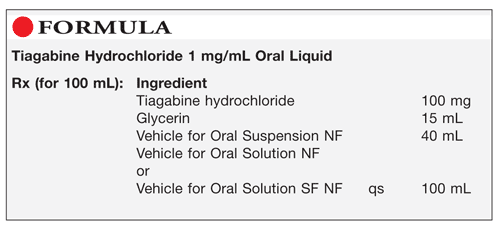US Pharm. 2011;36(1):72-73.

Method of Preparation: Calculate the required quantity of each ingredient for the total amount to be prepared. Accurately weigh or measure each ingredient and obtain the required number of tiagabine tablets. Thoroughly pulverize the tablets in a mortar and reduce the particle size using a pestle. Add the glycerin and mix to a smooth, uniform paste. Add the Vehicle for Oral Suspension NF and mix well. Add sufficient Vehicle for Oral Solution NF or Vehicle for Oral Solution SF NF to volume and mix well. Package and label.
Note: Numerous commercial vehicle products are available that may be used for this preparation. Please check the composition and pH for appropriate use when using different vehicles.
Use: Tiagabine hydrochloride oral liquid is used as an anticonvulsant in patients who cannot take the oral solid form of tiagabine.
Packaging: Package in tight, light-resistant containers.1
Labeling: Shake well before taking. Keep out of the reach of children. Discard after ____ [time period].
Stability: A stability study for tiagabine 2 mg/mL in a 1:1 mixture of Ora-Plus and Ora-Sweet was found to be stable for 61 days at 23°C to 25°C and for 40 days at 3°C to 5°C. The USP default date of 14 days when stored in a refrigerator may also be used.1,2
Quality Control: Quality-control assessment can include weight/volume, pH, specific gravity (SG), active drug assay, color, rheologic properties/pourability, physical observation, and physical stability (discoloration, foreign materials, gas formation, mold growth).2
Discussion: Tiagabine hydrochloride (Gabitril, C20H25NO2S2.HCl, MW 412.02) is a nipecotic-acid derivative that is used as an anticonvulsant. It differs structurally from other currently available anticonvulsant agents. It occurs as a white to off-white powder that is sparingly soluble in water. Tiagabine hydrochloride is administered orally; food will delay, but not decrease, the extent of tiagabine absorption. The labeling states that tiagabine should be taken with food. Gabitril is available commercially as 2-mg, 4-mg, 12-mg, 16-mg, and 20-mg film-coated tablets. The tablets also contain ascorbic acid, colloidal silicon dioxide, crospovidone, hydrogenated vegetable oil wax, hydroxypropyl cellulose, hydroxypropyl methylcellulose, lactose, magnesium stearate, microcrystalline cellulose, pregelatinized starch, stearic acid, and titanium dioxide, along with an FD&C or D&C dye, depending upon the tablet strength.1,3,4
Glycerin (glycerol, 1,2,3-propane triol) occurs as a clear, colorless, odorless, viscous, hygroscopic liquid with a sweet taste about two-thirds as sweet as that of sucrose. It has an SG of about 1.25 and a melting point of 17.8°C; if cooled to crystallization, it will need to be heated to about 20°C to melt. It is miscible with water, methanol, and 95% ethanol; practically insoluble in oils and chloroform; and slightly soluble in acetone. It is hygroscopic and should be stored in airtight containers in a cool place.5
Vehicle for Oral Suspension NF is an oral suspending vehicle that retains its suspending properties after being diluted with water, flavoring agents, or syrups. It has a pH of approximately 4.2 and an osmolality of about 230 mOsm/kg. Vehicle for Oral Suspension NF is a thixotropic vehicle with a viscosity of approximately 1,000 cps at 25°C. It contains purified water, microcrystalline cellulose, sodium carboxymethylcellulose, xanthan gum, carrageenan, sodium phosphate, and citric acid as buffering agents; simethicone as an antifoaming agent; and potassium sorbate and methylparaben as preservatives.1
Vehicle for Oral Solution NF is a flavoring vehicle for oral extemporaneous preparations. It contains glycerin and sorbitol to minimize or prevent the sticking of caps on bottles, a problem associated with many syrups. Vehicle for Oral Solution NF is buffered to a pH of approximately 4.2. It contains purified water, sucrose, glycerin, sorbitol (5%), flavoring, sodium phosphate, and citric acid as buffering agents, and potassium sorbate and methylparaben as preservatives.1
Vehicle for Oral Solution SF NF is a sugar-free syrup used as a flavoring vehicle for oral extemporaneous preparations. It is alcohol free and is flavored with a citrus-berry flavor blend. Vehicle for Oral Solution SF NF is buffered to a pH of approximately 4.2 and may be used alone or in combination with other vehicles. It may be diluted with dissolved actives in water or suspending agents. Vehicle for Oral Solution SF NF contains water, sodium saccharin, xanthan gum, glycerin, sorbitol, citric acid, and sodium citrate as buffers; methylparaben, propylparaben, and potassium sorbate as preservatives; and flavoring agents.1
REFERENCES
1. USP Pharmacists' Pharmacopeia. 2nd ed. Rockville, MD: U.S. Pharmacopeial Convention, Inc; 2008:264,265,775-779,1440,
2. Haase MR, Khan MA, Bonilla J. Stability of two concentrations of tiagabine in an extemporaneously compounded suspension. IJPC. 2003;7:485-489.
3. McEvoy GK. AHFS Drug Information 2010. Bethesda, MD: American Society of Health-System Pharmacists; 2010:2142-2144,2293-2295.
4. Physicians' Desk Reference. 64th ed. Montvale, NJ: Thomson PDR; 2010:972-978.
5. Alvarez-Nunez FA, Medina C. Glycerin. In: Rowe RC, Sheskey PJ, Quinn ME, eds. Handbook of Pharmaceutical Excipients. 6th ed. London, England: Pharmaceutical Press; 2009:283-286.
To comment on this article, contact rdavidson@uspharmacist.com.





